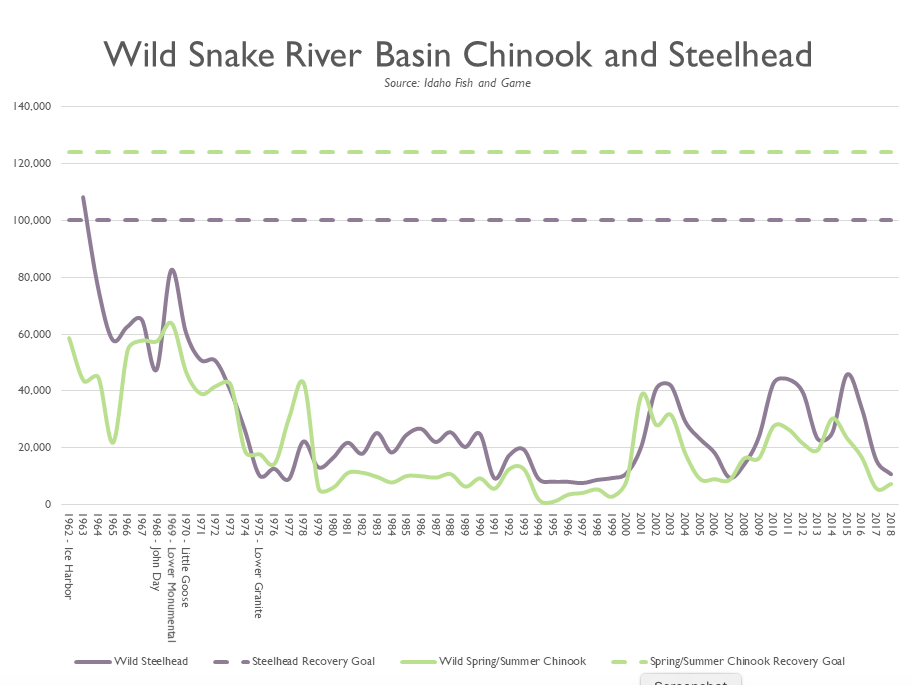forum
library
tutorial
contact

4 Governors Agree to Work Together as
NW Salmon may Have Just 20 to 30 Years Left
by Annette Cary
Tri-City Herald, October 9, 2020
|
the film forum library tutorial contact |

|
4 Governors Agree to Work Together as
by Annette Cary
|
The governors of Washington, Oregon, Idaho and Montana have agreed to work together to rebuild the Columbia River system's salmon and steelhead stocks.
They may not all agree on the adequacy of the recently completed comprehensive environmental study of the Columbia and Snake hydrosystems, which resulted in a decision by federal agencies in late September to maintain the four lower Snake River hydroelectric dams in Eastern Washington state.
"However, regardless of those differences and separate from each state's recourse, we commit to this ongoing collaboration," said the agreement made public on Friday.
The four states will use the goals of the Columbia Basin Partnership Task Force for rebuilding 24 stocks of salmon and steelhead. They also will consider the social, cultural, economic and environmental factors identified by the task force when deciding how to achieve those goals.
The task force was formed by the Marine Fisheries Advisory Committee of the National Oceanic and Atmospheric Administration in 2017 and included the four states, Columbia Basin tribes and those with fishing, agriculture, conservation, river transportation, port and hydropower interests.
Advancement of the goals will be done in a public process that includes state residents, federal agencies and tribes, which have treaty and cultural rights to natural resources and will include discussion of regional issues, the agreement said.
The collaborative process among the four states is intended to provide a science-based approach to strategies and actions, the agreement said.
It pledges to help improve fish stocks to uphold treaty rights, support state fishing objectives and protect economies dependent on the river.
Eastern Washington communities have rallied to retain the lower Snake River dams that are used for barging farm crops and other goods, some irrigation, recreation and to supply low-cost hydropower to the region.
But elsewhere in the region, commercial fishing operations and recreational anglers have called for more drastic action than the new federal decision to help threatened and endangered populations of salmon species. The federal decision calls for increasing the water spilled over four lower Columbia River dams and the four Lower Snake River dams to help fish passage.
Northwest RiverPartners said it expects a multi-year effort under the agreement to establish processes and decision-making groups to find solutions for struggling salmon populations.
 HYDROPOWER CONCERNS
HYDROPOWER CONCERNS
The organization supports the goals of the agreement, but stresses that the process must have scientific rigor and include a holistic look of salmon environments that includes the warming of the Pacific Ocean.
Northwest RiverPartners represents community-owned utilities in six western states and farmers, ports and businesses that rely on hydropower and low-carbon transportation.
"While there are many stakeholders who genuinely believe that dams have been the limiting factor in salmon recovery, recent research has shown that this anti-dam conclusion is not scientifically founded," Northwest RiverPartners said.
Salmon populations have declined worldwide in rivers with and without hydroelectric dams, with climate change likely to blame, it said.
It cited the recently released Biological Opinion, in which NOAA Fisheries said that climate change appears to have a much larger effect on salmon survival in the oceans than in rivers.
NOAA Fisheries also said that chinook salmon may only have 20 to 30 years left in the region if the observed relationships between warming ocean temperatures and salmon survival remain steady.
In addition, scientists at the University of Alaska pointed to a more hostile ocean environment due to climate change and salmon spending fewer years at sea as chinook salmon in Alaska's rivers are significantly smaller than they were in 1960, Northwest RiverPartners said.
The governors' process needs to ensure the vitality of the hydropower system as a means to prevent more harm to salmon from climate change and also harm to people, including from devastating wildfires, the organization said.
ENVIRONMENTAL GROUPS
Environmental groups across the Pacific Northwest praised the four-state agreement.
A joint statement from eight groups pointed out that the recent environmental study, the Columbia River System Operations Final Environmental Impact Statement, found that restoring a freely flowing lower Snake River by removing the earthen portions of the four federal dams there would be the most effective salmon restoration action.
The statement came from American Rivers, the Association of Northwest Steelheaders, the Sierra Club, Nimiipuu Protecting the Environment, Save Our Wild Salmon Coalition, the National Wildlife Federation, Defenders of Wildlife and Whale and Dolphin Conservation.
"We believe that major changes need to occur in order to restore the salmon runs within the Nez Perce Territory," said Elliott Moffett, president of Nimiipuu Protecting the Environment. "The status quo has not and will not work."
It is critical that the agreement delivers clear steps and a timetable for achieving healthy, harvestable salmon runs, strengthening the economy and ensuring reliable, affordable clean energy, said Wendy McDermott, the regional director for American Rivers.
"This can't be more of the same old bureaucracy," said Chris Hager, executive director of Association of Northwest Steelheaders. "We've spent decades talking about restoring the lower Snake River. This new process needs to result in urgent actions if we are going to have any chance of recovering our world-class salmon runs."
Not just salmon, but the iconic Southern Resident orcas that feed primarily on chinook salmon that are at risk, the groups pointed out.
"Two new calves have recently been born into this struggling population, and to ensure they grow up healthy and help this beloved group of orcas come back from the edge of extinction, we must make sure they have what they need to survive and thrive," said Colleen Weiler of Whale and Dolphin Conservation.
learn more on topics covered in the film
see the video
read the script
learn the songs
discussion forum
